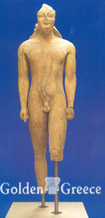
Samos
Samos, a member of the Ionian Dodecapolis, is located opposite Mykali, where the sanctuary of Heliconius Poseidon, which was also the seat of Panionion. The ancient city of Samos is located in the SE. beach, in today's Pythagoreion (formerly Tigani), a place continuously inhabited from the latest Neolithic era (5th millennium BC) to historical times. In the wider area of Pythagoras, the geometric settlement is also sought. The geometric cemetery is excavated.
Hellenistic houses on Kastro hill near Pythagorion. Roman mansions with impressive mosaics, a theater as well as an aqueduct, from Hellenistic and Roman times, are found throughout the entire area of the ancient city. Near the beach, the monumental Hadrianian baths stand out, on the site of the 3rd century gymnasium. BC, built according to the plan followed in Rome and Ephesus, with the stadium adjacent. The city of Samos was connected by a sacred road with the sanctuary of Hera (Heraion) at a distance of 7 km., one of the most important sanctuaries of the ancient Greek world. A fortified settlement developed in this location from the early Bronze Age (3rd millennium BC) which continued into Mycenaean times (14th - 13th centuries BC). Possible outdoor worship. Traces of four successive temples of the goddess are preserved in approximately the same location and of other smaller ones, of superimposed altars, a multitude of votive bases in the sacred road, from where the great marble sculptures of the Archaic times, which are today in the Vatheos Museum, and ancillary buildings (tanks, fountain, arcades) from the Geometric to the Roman times. The votive offerings to Hera were numerous, testifying to the impact of her cult as well as the cultural relations of the Samians with the other regions of the Mediterranean, Asia Minor, Persia, Mesopotamia. The colossal Heraeus III (570 - 560 BC) was the work of the famous architects Roikos and Theodoros. Heraeus IV began to be built by the tyrant Polycrates in 525 BC. approx., and continued into classical and Hellenistic times, without ever being completed. From this temple, part of a column is still standing today.
In the area of the ancient sanctuary, a three-aisled early Christian basilica (first half of the 6th century). A baptistery and other additions belonged to the same complex. In Pythagoras, the basilica of Kastro, the basilica of Tria Dontia, the basilica of Panagitsa (perhaps part of a monastic complex), a building of uncertain use with an arch and a mosaic floor, an underground cemetery with arcosolia (4th - 6th c.) and remains of an early Christian wall near Basilica of the Castle. South-east of the basilica of Panagitsa baptistery, in the area of a Roman bath. In Kedro (chapel of Agia Paraskevi), remains of an early Christian basilica and baptistery.
Editor: Fotini Anastasopoulou